
Patients With ILD in Rural Areas Face Barriers to Care
Key Takeaways
- Rural ILD patients experience significant diagnostic and treatment delays compared to urban counterparts, highlighting access challenges.
- Telehealth shows promise in improving access to ILD care, facilitating virtual visits and support services for rural patients.
While citing overwhelming barriers patients in rural areas face when accessing care, providers noted the potential of telehealth to improve access in a survey.
Health care providers for patients with interstitial lung disease (ILD) living in rural areas reported ongoing challenges with providing sufficient care to their patients, a study published in
More than half (57%) of the 68 providers reported that their rural patients experienced delays in receiving a diagnosis compared to their patients living in urban areas, and just under half (47%) reported their rural patients experienced more delays in treatment.
While highlighting the need for policies aimed at improving access to care for these patients, the researchers recognized the increasing promise of telehealth, which continues to improve access to care for the group of disorders that includes
Approximately 1 in 3 (30%) of providers mentioned telehealth as a facilitator of care, using the technology to have virtual visits, message with patients, and increase access to patient support groups and other supportive services.
“The emergence of telehealth as a facilitator to ILD care in our study has promising implications,” explained the researchers. “Studies of telehealth in ILD have largely examined its use for home monitoring or as an alternative to in-person visits, and most patients and providers have described it as a positive experience and agree that it facilitates access to ILD care.”
The researchers flagged additional research needed to gain insights on perceived barriers among rural patients themselves and their local providers, as all providers participating in the survey were part of the Pulmonary Fibrosis Foundation Care Center Network (PFF-CCN). Almost all (97%) providers reported seeing at least 1 rural patient in the previous 6 months. One-third of the providers estimated that rural patients made up to half of their patient load.
Poor access to care was overwhelmingly noted in responses (73% of responses), with providers reporting issues with accessing diagnostic tests, such as laboratory and lung function tests, and limited availability of pulmonary rehabilitation (PR) and home oxygen. Level of effort in having to access appropriate doctors was also highlighted, with patients sometimes having to drive multiple hours or take flights to access appointments.
Multiple providers noted having limited resources to coordinate care for patients (23% of responses) stemming from several factors, such as “difficulty obtaining timely labs/test results from outside health centers” and “lack of local providers to coordinate with.”
“Our themes of poor access to care and limited resources as barriers to ILD care are consistent with a broad range of studies in rural areas that have demonstrated worse access to specialty and primary care providers, home oxygen, lung transplantation, and health care facilities, including PR centers, pulmonary function laboratories, and centers performing CT scans,” detailed the researchers.
The effect of disparities in access to care reported in the current and previous studies is mixed. In one study of 1600 patients with ILD,
Meanwhile,
Authors of the current study concluded that there are several barriers to diagnosing, treating, and monitoring rural patients, but also tools such as telehealth that may help facilitate access.
"The results of this survey can be used to inform the development of clinical and research partnerships between rural patients with ILD, rural health providers, ILD care teams practicing at PFF-CCN sites, and patient advocacy organizations that focus on increasing access to equitable ILD care for patients living in rural areas," the authors wrote.
References
- DeDent AM, Shore JE, Bascom R, et al. Caring for rural patients with interstitial lung disease: perspectives of Pulmonary Fibrosis Foundation Care Center Network nurses and providers. CHEST Pulm. Published online January 21, 2025. doi:10.1016/j.chpulm.2025.100136
- Welsh ET. Patients living with ILD living in rural areas do not have worse outcomes, study finds. Healio. Published online October 16, 2022. Accessed May 29, 2025.
https://www.healio.com/news/pulmonology/20221016/patients-with-ild-living-in-rural-areas-do-not-have-worse-outcomes-study-finds - Jeganathan N, Sathananthan M. Urban-rural differences in idiopathic pulmonary fibrosis-related mortality rates in the United States. CHEST. 2023;165(5):924-928. doi:10.1016/j.chest.2023.11.008
Newsletter
Stay ahead of policy, cost, and value—subscribe to AJMC for expert insights at the intersection of clinical care and health economics.








































